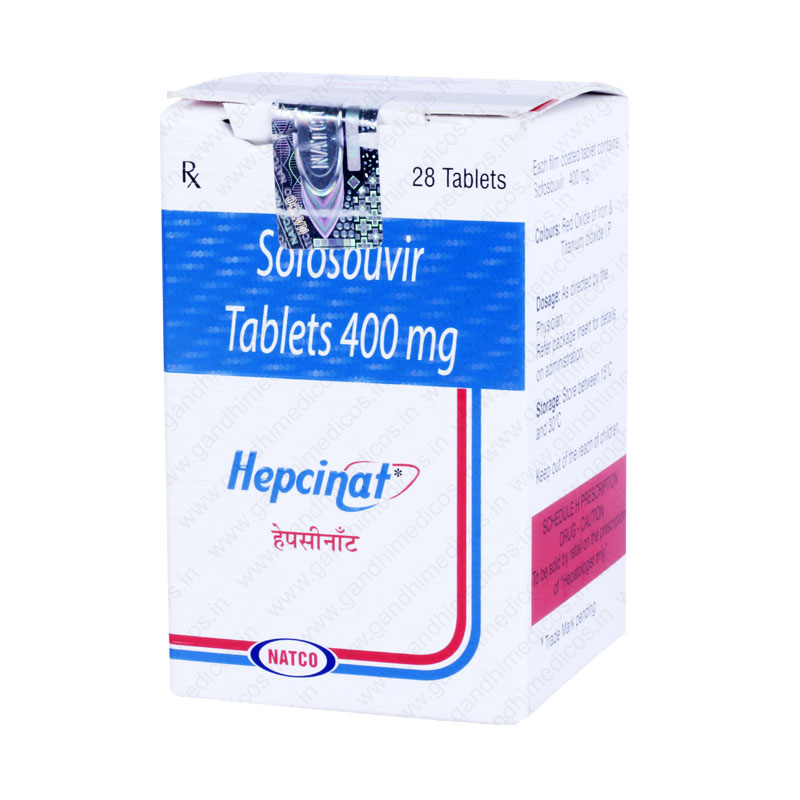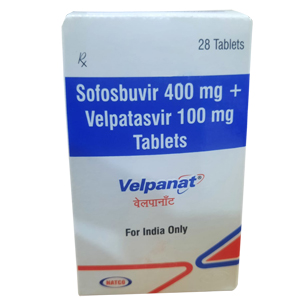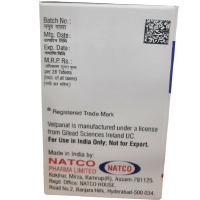Hepcinat
| Product Name | Hepcinat |
| Dose/Strength | 400 mg |
| Packaging Size | 28 Tablets |
| Brand | |
|---|---|
| Salt |
Thank you for your enquiry. We will get back to you shortly!

Lowest price guaranteed

Worldwide shipping

Genuine / original products

Fast Delivery
Category: Hepatitis C
Description
Hepcinat 400 mg (Sofosbuvir) is an antiviral drug used for patients suffering from chronic hepatitis C viral (HCV) infection in adults. As HCV has 9 distinct genotypes, hepcinat 400 mg (sofosbuvir) is specified against genotype 1, 2, 3 or 4.
Sofosbuvir is known as a direct-acting antiviral (DAA) drug i.e it specifically inhibits a special type of protein (non-structural protein 5B (NS5B) RNA polymerase] which prevents further multiplication (RNA replication) of viral cells.
Hepcinat 400 mg (Sofosbuvir) is recommended in combination with other anti-HCV agents (ribavirin and pegylated interferon) for achieving a sustained virologic response (SVR) after the completion of therapy. The combination gives noteworthy long-lasting benefits like,
- Enlightening the quality of life of patients
- Reducing the damages associated with liver
- Slowing down the chances of procuring liver cancer (hepatocellular carcinoma)
Administration of Hepcinat 400 mg (Sofosbuvir):
Hepcinat 400 mg (Sofosbuvir) is administered orally once in a form of 400 mg dose daily with or without food. Besides, either ribavirin alone or ribavirin plus pegylated interferon is also recommended for sustainable effects. The suggested drug regimen is shown in the table below.
Dosage regimen for Hepcinat 400 mg (Sofosbuvir)
| HCV genotype | Recommended dosage (mg) | Duration (weeks) |
| Type 1 or 4 | Hepcinat 400 mg (Sofosbuvir) plus ribavirin and pegylated interferon | 12 |
| Type 2 | Hepcinat 400 mg (Sofosbuvir) plus ribavirin | 12 |
| Type 3 | Hepcinat 400 mg (Sofosbuvir) plus ribavirin | 24 |
Once swallowed, sofosbuvir is absorbed (bio-available) in between 30 mins to 2 hours. It has a pertinent binding affinity (61-65%) with viral cells and is broadly metabolized in the liver. After its activities, more than 50% of the drug is excreted from the body in between 40 minutes to 27 hours.
Special conditions:
If HCV patients are unable to take the interferon-based regimen:
Administer Hepcinat 400 mg (Sofosbuvir) and ribavirin for 24 weeks instead of 12 weeks.
If HCV patients have liver cancer waiting for their liver transplantation:
Administer Hepcinat 400 mg (Sofosbuvir) and ribavirin for 48 weeks or until the day of transplantation.
Note: Both pros and cons should be taken into consideration before increasing the duration of treatment.
When should Hepcinat 400 (Sofosbuvir) be avoided or used cautiously?
Interactions with other drugs:
If patients were taking other drugs before or along with sofosbuvir.
There are certain disadvantages like,
- The efficacy gets comprised
- Dosages need to be modified
- Shows a higher rate of side-effects
Hepatitis B viral infection:
If patients are suffering from or had a history of Hepatitis B viral infection before taking sofosbuvir.
Others warnings:
- If patients had a liver transplant before the initiation of dosage
- If patients have complications in the liver other than HCV infection
- If patients are suffering from heart problems, kidney disease or undergoing dialysis, HIV infection, or other severe medical condition
- If patients are pregnant and planning to breastfeed
Side-effects of Hepcinat 400 mg (Sofosbuvir):
Sofosbuvir has a good safety profile with minimal side-effects. Due to its safety profile, it has a therapeutic advantage over other anti-HCV agents with the absence of low red blood cell (RBC) count (anemia) and neuropsychiatric effects.
Serious side-effects: Slow heart rate (bradycardia)
Side-effects in combination with ribavirin:
- Headache
- Tiredness (Fatigue)
Side-effects in combination with ribavirin and pegylated interferon:
- Lack of sleep (Insomnia)
- Nausea
- Tiredness (Fatigue)
- Headache
Uncommon side-effects:
- Diarrhea
- Severe rashes on the skin
- Fever
- Chills
- Low consumption of diet
- Pain in the muscles (Myalgia)
- Physical weakness (Asthenia)
- Skin itchiness (Pruritis)
Note: These are not all possible side-effects of Hepcinat 400 mg (Sofosbuvir), please ask your doctor for more information regarding the same.
Reviews (0)
Be the first to review “Hepcinat” Cancel reply
About Natco


 Anti Cancer Drugs
Anti Cancer Drugs Hepatitis C
Hepatitis C Meds for HIV
Meds for HIV Ayurvedic Medicine
Ayurvedic Medicine Transplant Medicine
Transplant Medicine Respiratory System
Respiratory System +91-9999064250 / 9811604424 / 9811604444
+91-9999064250 / 9811604424 / 9811604444
 8(800)100-47-90
8(800)100-47-90



















Reviews
There are no reviews yet.